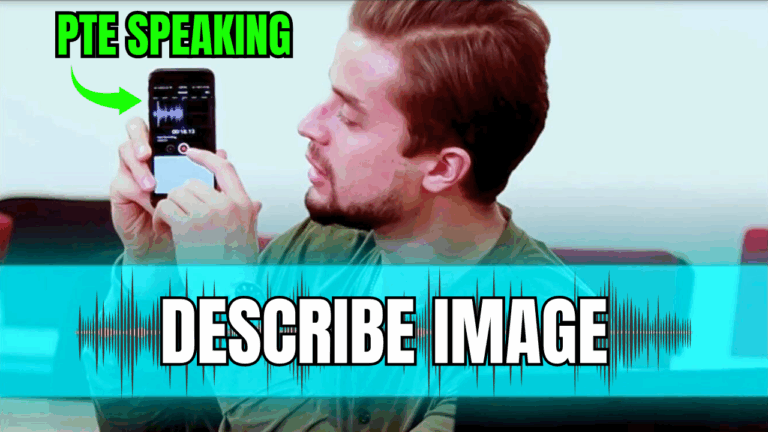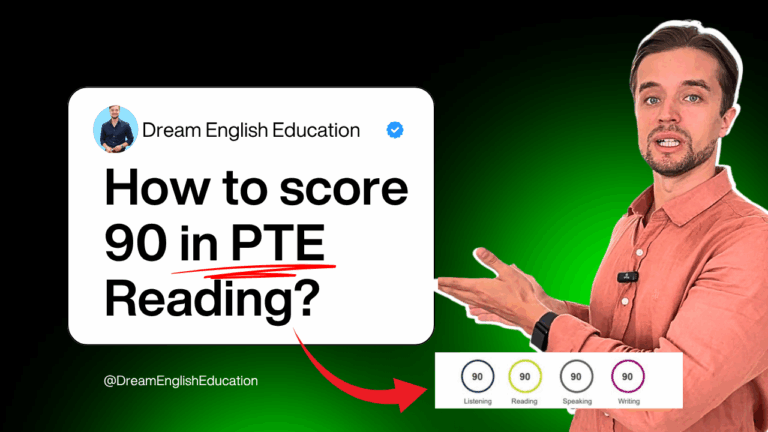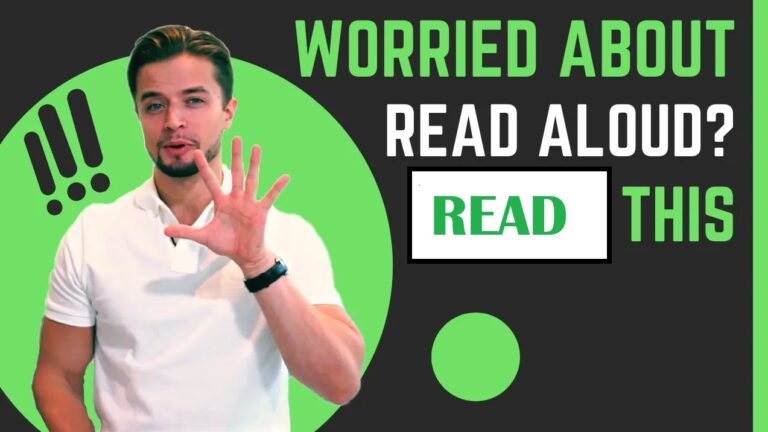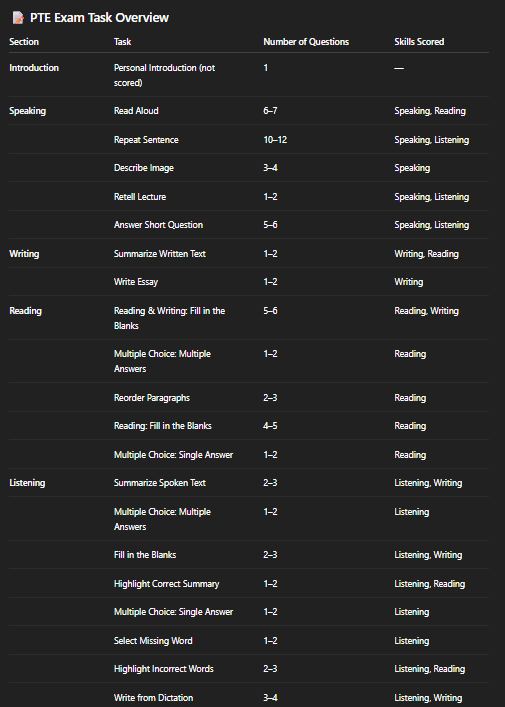2025 PTE Exam Pattern, Structure & Format – FULL Test Overview
What you need to know about the PTE Exam Pattern, Structure & Format
So, you’ve decided to take the PTE Academic test. Awesome choice!
But now you’re probably looking at all the information online and thinking…
“What does the full test even look like?”
“How many parts are there?”
“What kinds of questions will I get?!”
“Am I going to be sitting there for 5 hours?!”
Feeling a bit lost? Don’t worry! That’s totally normal.
In this post, I’m going to break down the ENTIRE PTE exam pattern for you, step-by-step. No confusing jargon, just a simple, clear overview so you know EXACTLY what to expect on test day.
Let’s get you ready!
The BIG Picture: How is the PTE Test Structured?
First, let’s get one thing straight: the PTE Academic is a single, 2-hour test taken on a computer.
That’s it. You don’t have to come back on different days for different sections. You go in, sit down, and get it all done in one go at the test center.
The test is broken down into 4 sections. Let’s dive into each one.
Part 1: PTE Speaking Format & Topics
Time: Approx. 25-30 minutes
This is the first and most important part of the test. Most important because PTE Speaking also gives A LOT of marks in your Reading and Listening sections.
To emphasize what we mean, check the score below from the Official PTE Mock Test – where we ONLY answered the speaking questions. We don’t actually recommend the official mocks, as they’re quite expensive (~50aud/each), you can’t actually see your mistakes but just the score, and if you’re not using the proper mic – the result is often terrible.
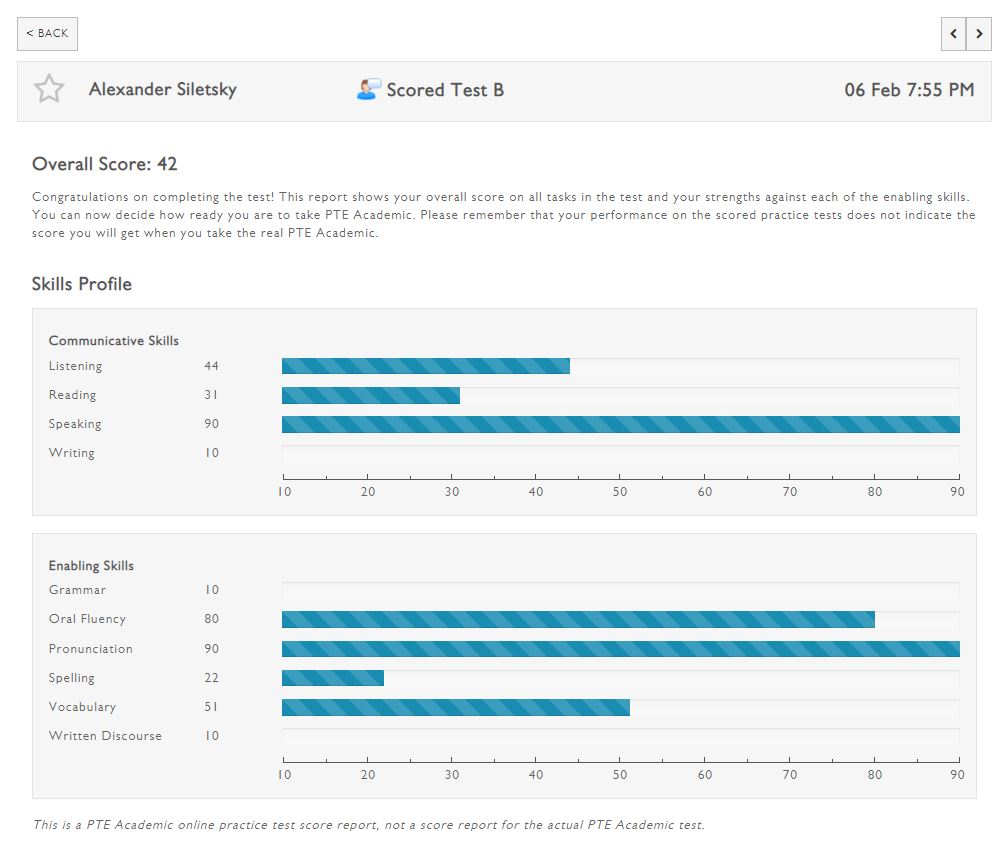
What you’ll notice is that we got 44 points in PTE Listening and 31 points in PTE Reading – just by doing the speaking. This is why you need to absolutely master speaking, and understand how the marks are given.
Here are the question types you’ll face, in order:
- Read Aloud (6 or 7 questions)
- Repeat Sentence (10 to 12 questions)
- Describe Image (3-4 questions)
- Retell Lecture (1-2 questions)
- Answer Short Question (5-6 questions)
- Summarize Group Discussion (2-3 questions)
- Respond to a Situation (2-3 questions)
👉 Pro Tip: This section is where you first see PTE’s “integrated scoring.” For example, your Read Aloud performance gives you points for Speaking AND Reading! More on that later.
Part 2: PTE Writing Format
Time: Approx. 30-40 minutes
Writing is actually the EASIEST section in PTE – and much easier than the writing section in other English exams like IELTS. You only have 2 question types, and both are scored 100% by the computer (NOT a human being):
- Summarize Written Text (2 questions)
- PTE Essay (1 question)
Although the last two questions are part of writing (and technically separate) – the timing for them both is combined. Where you will spend ~25-30min on Speaking, and 30 or 40 questions on Writing (depending on the number of tasks.
Part 3: PTE Reading Format
Time: Approx. 29–30 minutes
After you finish the Speaking & Writing part, you’ll move straight into the Reading section. This part tests your ability to understand written English.
Here are the question types you’ll see:
- Reading & Writing: Fill in the Blanks – SUPER IMPORTANT! (5-6 questions)
- Multiple-Choice, Multiple Answer (1-2 questions)
- Reorder Paragraphs (2-3 questions)
- Reading: Fill in the Blanks – ALSO SUPER IMPORTANT! (4-5 questions)
- Multiple-Choice, Single Answer (1-2 questions)
Part 4: PTE Listening Format (The Final Boss!)
Time: Approx. 30–43 minutes
This is the final part of the test. You’ll listen to various audio or video clips and answer questions based on what you heard.
Here are the question types in this section:
- Summarize Spoken Text (1-2 questions)
- Multiple-Choice, Multiple Answer (1-2 questions)
- Fill in the Blanks (2-3 questions)
- Highlight Correct Summary (1-2 questions)
- Multiple-Choice, Single Answer (1-2 questions)
- Select Missing Word (1-2 questions)
- Highlight Incorrect Words (2-3 questions)
- Write from Dictation – this is the KING of all questions! 👑 (3-4 questions)
The Secret Sauce: PTE’s Integrated Scoring 🤯
This is the #1 thing that confuses new students. Unlike other exams, in PTE, one question can give you points in multiple skills (here’s a related blog post).
Example 1: When you do Repeat Sentence, you listen and then speak. So you get points for Listening AND Speaking.
Example 2: When you do Write from Dictation, you listen and then write. So you get points for Listening AND Writing.
This is why someone can get a lower score in the “Reading” section but still get a 90 in Reading overall! It’s because tasks like Summarize Written Text (from the Writing section) contributed heavily to their Reading score. Understanding this is key to practicing smart!
You’ve Got This!
And that’s it! That’s the entire PTE exam pattern from start to finish. It might seem like a lot, but now you know exactly what’s coming. No more surprises!
Your next step is to start practicing the question types, focusing on the ones that give you the most points.
Good luck!
Alex
PS: Ready to start practicing? Our PTE Practice Platform has thousands of questions that mimic the real exam format.
PPS: Want to see what these question types look like in action? Check out our the video below for detailed tutorial with one of our teachers


